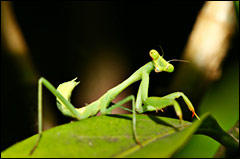Dear Umbra,
I have a pest problem in my backyard — specifically, some tiny (but apparently hungry) insect is making lace out of my basil leaves. I do not want to use pesticides for many reasons, not the least of which is that I cook with the herbs I grow.
I think I have found a “natural” solution, but I wanted to consult you first. My garden-supply store sells praying-mantis egg cases (“The natural pest control solution! Over 200 insects inside! Hang on a tree and eggs will hatch when temperatures stay above 70 degrees for three weeks!”) The store also sells bags of dormant ladybugs for the same purpose. My question is: should I buy these bugs? Or will unleashing them just upset the natural balance and biodiversity of my rather small backyard?
Bugged,
Lindsay Ratcliffe
Helotes, Texas
Dearest Lindsay,
It’s common to see these entrapped insects in garden stores now, and sustainable farmers often use beneficial insects for pest control, but they are not a cure-all. Before you do anything to deal with your basil perforator, you need to take the official First Step of natural pest control: positively identify the pest. Without knowing what is causing the holes, you can’t take an effective step to stop it/them. Let’s identify together, and then I’ll get to your main question.

Pray tell, which way to the buffet?
Photo: iStockphoto
Usually I would use a pest and disease book I got at a used bookstore, from the Rodale Organic Gardening imprint, but today the internet will connect us all. Before looking it up in any book or computer, one should go out and look closely at the plant. One may actually see the pest in action. If not, note where the damage is happening — on all leaves, on the oldest leaves, on the stem, etc. — and hazard a guess as to whether it looks like an insect or a disease. Next, on to the internet. I’m entering “basil pests” first and getting several websites describing major pests of basil, which include aphids, slugs, Japanese beetles, white flies, grasshoppers, and flea beetles. Further limiting the search with “Texas” gets me to Texas Extension, and they only suggest Japanese beetles, then I’m on to “Japanese beetle damage” — whoa. Ick. That’s pretty dang lacy. You get the idea. After you have identified which pest is damaging your plant, find out what its predators are. If neither ladybugs nor praying mantises consider your pest to be dinner, part of your question is answered (“no”).
As an aside: step two of natural pest control is to do a series of less-toxic interventions. These include habitat modification (killing the host plant, removing the places where pests nap, etc.), mechanical control (this includes squishing and picking off), barrier techniques (deer fence is an example), and less-toxic pest controls (this is where the ladybugs come in). Last resort would be the toxic interventions.
Back to your question.
If ladybug or mantis dinner is in your garden, we have the larger question of whether buying insects and releasing them is worth the money, and your concern about destroying your yard. I don’t think it’s worth it. Mantises are general predators. Although they might eat your mystery pest, they might also eat the various unsung beneficial insects already in your yard (aka, destroy the yard, although destroy is too strong a word), and they might eat each other, completely defeating your primary purpose. Ladybugs eat aphids and a few other soft-bodied insects. The Asian multicolored ladybug is an introduced species that is displacing native ladybeetles — you may have Asian lady beetles infesting your home. Here are some tips to avoid such a fate, and photos to help identify your own ladybugs. If you release ladybeetles, a few might land, eat, and breed, but it’s likely that the bulk of them will fly away, and this is why I think ladybug sales are hokum. If you have aphids, any ladybeetles already in the vicinity will eventually come find them and eat them. I don’t know how they find them, maybe smell.
A big part of pest control is creating a yard (and neighborhood) in which natural predators and beneficial insects such as spiders, beetles, and ladybeetles live and reproduce, adding to the yard’s diversity. This won’t mean you have no pests, alas, and when you find out what is eating your basil you’ll still have to find out how to stop it. For your sake, I hope it isn’t Japanese beetles.
Preyingly,
Umbra

